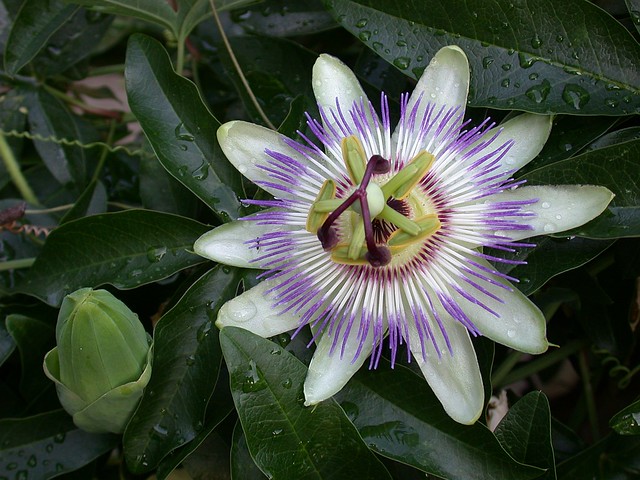
Passiflora caerulea, a beautiful monster
There are some plants that, beautiful though they may be, you should be wary of inviting into your garden. These are plants that grow so fast, so big, and propagate themselves with such enthusiasm, that they will bully and overwhelm anything the least bit slow or small or dainty until one day in mid to late summer, you realize that several of your most precious plants are missing.

Tetrapanax papyrifer
I first encountered Tetrapanax papyrifer, a.k.a. "ricepaper plant", in The Exotic Garden, a 1988 book by British gardener and author Myles Challis that helped kick off the current craze of tropical-influenced gardening with hardy plants that look tropical or otherwise exotic. I had recently purchased my current property when I found this book in a used book store in Philadelphia in 2001 or 2002. It had a huge influence on me, introducing me to a number of hardy plants that I determined to find and grow. Tetrapanax papyifer intrigued me with its description of a hardy plant with huge leaves so I ordered one from Woodlanders, an excellent nursery in South Carolina, and was on my way.

Tetrapanax papyrifer in my garden, August 2009
Tetrapanax papyrifer must be one of my favorite monsters because I've taken so many photos of it, in so many places, over the years. This species is the sole member of the genus Tetrapanax, a member of the aralia family (Araliaceae) and a close relative of Fatsia and Schefflera. The species is native to Taiwan, where it is quite variable in the wild with regard to leaf size and shape. The plant produces a woody stem, growing into a small tree and sprouting from root suckers, forming clonal colonies. It is this last characteristic that makes it something of a monster.
Originally described as Aralia papyrifera by W.J. Hooker in 1852 (go read the fascinating original description, with a wonderful color illustration), this species was moved to the new genus Tetrapanax in 1859 by K. Koch, and subsequently classified as Panax, Fatsia, Didymopanax, and Echinopanax, finally coming to rest back in Tetrapanax. The name "papyrifer" (often misspelled as "papyrifera" but "papyrifer" is correct for the masculine genus Tetrapanax) refers to the production of "rice paper" from its pith in China. Panax was one of the first genera to be described in the family (and subsequently incorporated into many other generic names in Araliaceae) and "tetra" probably referring to the four petals and stamens (5 of each in Panax).
The clone then commonly in cultivation did well for me, perhaps a little too well. Not only did it form a nice clump, but I would find new plants popping up several feet away from the nearest mature stem. Fortunately the suckers come up easily, pulling out with a long, rootless stem. The plant has a superficial resemblance to Gunnera, a genus we cannot grow on the east coast with our brutally hot summers. Unlike more truly tropical tropical plants, the foliage looks good well into the fall, surviving light frosts and not killed until the first hard freeze. But the stems were killed to the ground by even mild winters, acting like a giant perennial and returning the following year on the late side and not regaining its previous year's beauty until late in the year.
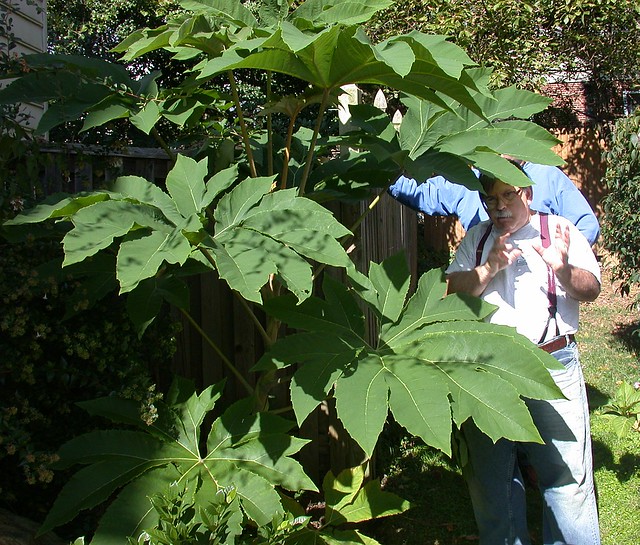
"It started out this big." Allen Hirsh with T. papyrifer 'Steroidal Giant', October 2005
In the early 2000's another selection became available. Its origin is somewhat unclear but it produced dramatically larger leaves than the older clone, and was given the cultivar name 'Steroidal Giant'. I first saw this plant at the home of my friend Allen Hirsh when he hosted one of the early DCTropics garden tours at his home in Silver Spring, Maryland. Al was one of the pioneer "zone pushers" in my area and his gardens deserve a blog post of their own! Al shared suckers from his plants with other local gardeners, and many of us are now growing it.
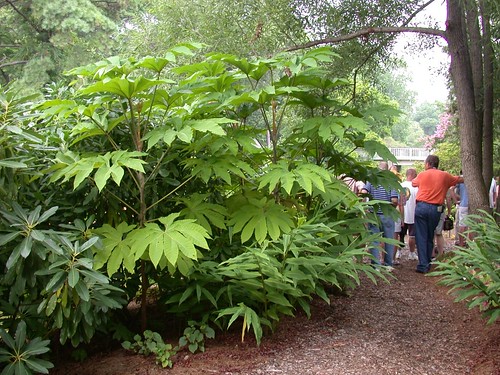
Tetrapanax papyrifer 'Steroidal Giant' (?), Norfolk Botanical Garden, August 2008
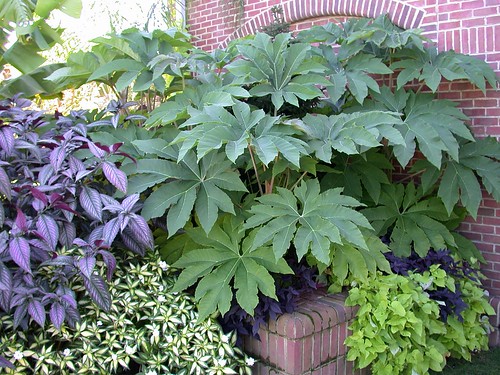
T. papyrifer 'Steroidal Giant', Baywood Greens, Long Neck, Delaware, September 2013
Besides being larger, 'Steroidal Giant' has distinctive, deeply lobed leaves. Perhaps more importantly, it has proven to be considerably hardier than the older clone. The stems of 'Steroidal Giant' survive all but the coldest winters in my area (zone 7a/b) and in its second year, it develops a distinctly palm-like appearance with a tuft of large leaves atop a bare trunk. A clump of 3 or more will produce a decidedly tropical effect but it's a good idea to place it where it won't be disturbed, as the stems, petioles, and leaf undersides produce small irritating hairs that can cause coughing fits and respiratory distress. I'm speaking from experience here.

Private garden, Portland, Oregon. (Photo courtesy of Loree Bohl, danger garden)
I should also note that this is the only plant that has sent me to the emergency room! A few years ago, I had cleaned up my garden in the spring by simply breaking off the dead woody stems a few inches above ground level. Yes, I really am that lazy and that stupid. The result was a bunch of sharp sticks and you can probably see where this is going. Later that summer, while working in the garden, I backed into one of these and drove a section of stem an inch into my calf. It snapped off but was so deeply and firmly embedded that I couldn't even pull it out; thank goodness Dan was home to drive me to the hospital. I did discover that when you go to the emergency room with something big and sharp sticking out of your leg, you get attention fast! Since then I've been careful to break or cut plant stems at or below ground level.
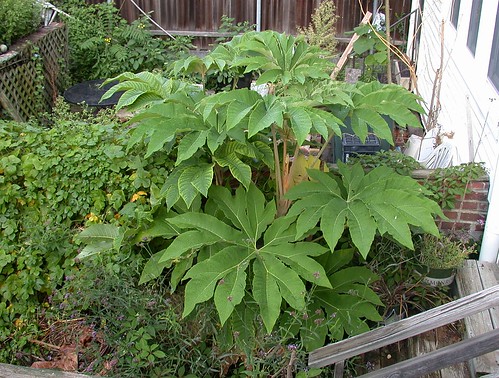
Tetrapanax papyrifer 'Steroidal Giant' makes an effective screen
I've only been growing 'Steroidal Giant' for a couple of years, but it proved its hardiness by surviving my area's coldest winter in 20 years in a pot outdoors. It also proved its invasiveness by popping up outside the pot as well! A few days ago I stuck my head out a back window and was struck by the overhead view of this plant, almost resembling a tropical Cecropia species.
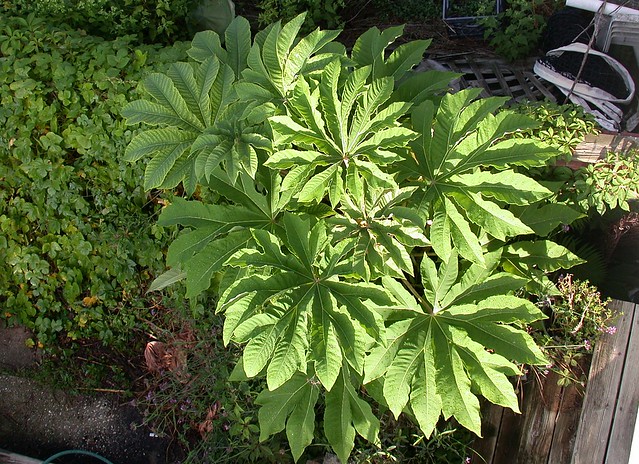
Tetrapanax papyrifer 'Steroidal Giant', overhead view
Culture: seriously? Plant it, and it will grow. Full sun, part sun, bright shade, it tolerates poor soils and is fairly drought tolerant. Like the monster it is, Tetrapanax papyrifer has already gobbled up far too much of this blog post! So very briefly, here are some more of the beautiful monsters I've grown.
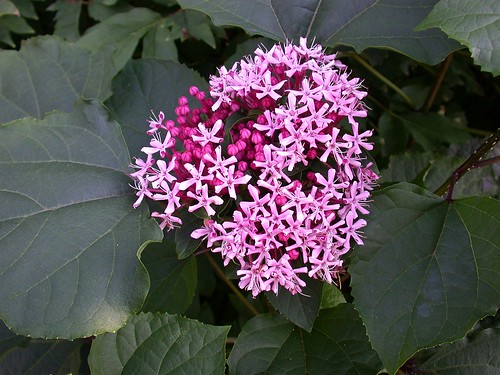
Clerodendrum bungei
Clerodendrum bungei is another of my favorite monsters. I obtained a plant from a local gardening friend several years ago and since then, it has spread all over my garden. Like Tetrapanax papyrifer, this species spreads aggressively by root suckers but unlike that plant, the suckers don't come up easily. But there's so much to like about this plant. The foliage is large, bold, and tropical-looking. The stems and foliage have an odd, unpleasant odor when handled or bruised, but the pink flowers are sweetly fragrant and very attractive to butterflies. And it blooms all summer and right up until frost. You just have to keep after it. The plant grows into a rather ungainly small shrub, but the stems can be cut to the ground to manage its size and new shoots will bloom in their first growing season.
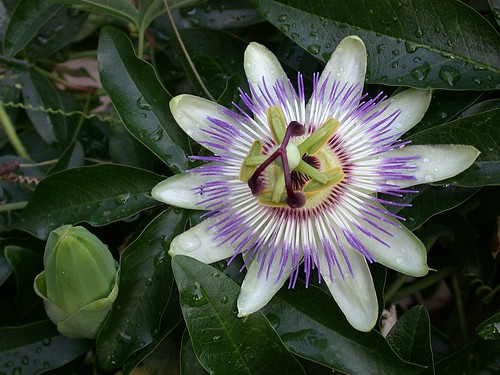
Passiflora caerulea
And finally, that plant with the seductive and photogenic flowers at the very top of this blog post, Passiflora caerulea. This plant isn't even supposed to be hardy in zone 7 but when I planted it, Al Hirsh warned me, "you'll be sorry". Generally rated as hardy to zone 8, I've found this rapacious, fast-growing vine great for hiding a chain-link fence but virtually unkillable and not just able but positively anxious to smother anything in its path. The stems will survive temperatures into the low teens, but after being killed to the ground by single digit temperatures this past winter, I thought it was gone for good. No such luck, I've been finding it all summer popping up from root suckers all over my garden, somehow growing five and size feet long by the time I find them and yank them out. I'm tempted to let it cover the fence again, which technically belongs to my neighbors; they've humored me with this vine, and dubbed the almost cartoonish flowers "Dr. Seuss flowers". But let's face it, sooner or later it's going to grab their dog or one of their children and I think that's the point where they'll stop humoring me.
What other plants would you nominate as "beautiful monsters"?
Did you like this post? Please click on the share buttons below to share on Facebook, Twitter, or Pinterest!

Tree Dandelion I nominate (Sonchus fruticosus), only thing is it's not that hardy...
ReplyDeleteTetrapanax is a must for every garden I think!
I was at a garden club meeting last night and the subject of Tetrapanax came up. We're starting to hear horror stories, as bad as running bamboo or worse, and one of my friends had to eliminate it after it starting invading his neighbor's yard!
DeleteI thought the same thing when I planted the veregated kudzu "Sherman's martch" but it has not been too bad!
ReplyDeleteTony Avent said they cut their back every couple of years. Definitely an interesting plant, but I'm not sure I would plant it!
DeleteAs you know I adore tetrapanax! Funny thing though, I have 3 patches and the one I really wish would sprout a couple of runners refuses too. Then there's the one out front which has gone under the neighbors driveway to pop up in their front yard...7 plants so far. Luckily she's happy to get them (for now).
ReplyDeleteWent to a talk last night with the guys from Dancing Oaks (they are visiting in the area) and they said Tetrapanax has not spread much for them, because the soil around it is fairly dry. It stays in the moist, irrigated area. Not sure my own neighbors would be very happy to have it popping up!
DeleteI would add Giant Variegated Petasites.It alao spreads, and requires close scrutiny to avoid it escaping into the yard. But I love it!
ReplyDeleteAbsolutely! Petasites is one of those plants I just can't grow because my garden is too small, and the soil gets too dry.
DeleteI'm really surprised tetrapanax and passion flower grow here. I thought our winters were too cold. I love Woodlanders and have been to the nursery. It's tucked away in a neighborhood in Aiken. If you didn't know it was there, you'd drive right by.
ReplyDeleteThe ordinary Tetrapanax is root hardy here--killed to the ground by most winters but coming back like a giant perennial--and the newer 'Steroidal Giant' is generally stem hardy. Even so, most were killed to the ground by this past winter, but are coming back strong. Passiflora caerulea is supposedly zone 8 but even when killed to the ground, as it was this year, it still comes up from the roots. I think these invasive qualities, and ability to resprout from underground stems or even as root suckers, pre-adapt these species to out-of-zone growing.
DeleteLooking for tetrapanax steroidal giant for sale northern virginia area
ReplyDeleteI'm sorry but Tetrapanax paprifyer is a horribly invasive plant and extremely difficult to control once it 'gets out'. I'm in Central Florida and it's taking over my woods. The pollen, flowers, and 'fuzz' also cause respiratory irritation and coughing. I can't even walk by without having a reaction.
ReplyDeletePlease don't plant this species.
Paul